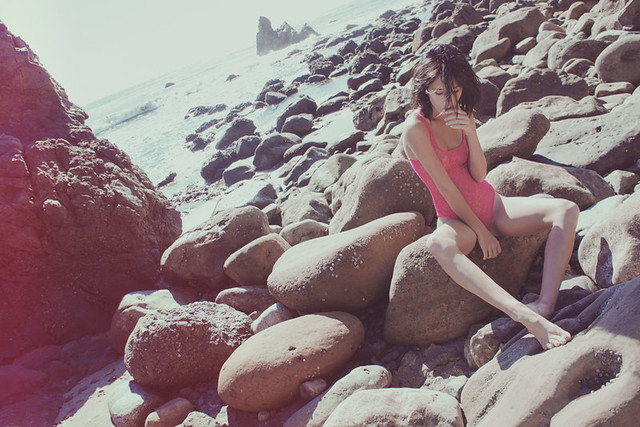
Rodney posted this in the Facebook Workshop Group:
here's a pic from day 1 of the Malibu fashion workshop. I took this with my iPhone and edited with a few apps... makes me wonder why bother with a dslr if the lighting is right.
And he's right. Why bother with a dSLR when the lighting is right? I did a whole shoot with the iPhone4 (not 4S) and its crummy sensor. And I survived! So what is the difference really between a camera-phone and a dSLR?
All things being equal, it's primarily latitude in the sensor's ability to represent dynamic range.
And there are two schools of thought when it comes to answering this question:
1) Compress the dynamic range of the shot with exposure-balancing tools (lights and reflectors) so you need and use less "sensor".
2) Leverage the technology (sensors, camera RAW, retouching, etc.) so you can shoot "as is" and manipulate in post.
In the old days of film, compressing the dynamic range of the shot was really important. Not necessarily because film had less latitude but rather because it was more difficult to manipulate in post-processing. You could always save highlights but this required the assistance of a great printer. Selectively dodging and burning anything was a huge pain in the ass.
These days Camera RAW, Photoshop, and sensors with 14+ stops of dynamic range make it easier to manipulate a capture. Sure the highlights don't go forever (though if you overcook the highlights you can save some of it) but it's much easier to recover highlights and boost shadows. You should see some of the poorly exposed images I've shot either by accident or as a function of my terrible 50mm lens, pictures that I've been able to process nonetheless without too much trouble. I definitely fall under the #2 school of thought. Just because the current technology is already so good that I don't find much of a need to heavily manipulate the dynamic range of my shot.
What does this mean for me?
It means I get to be more dynamic. I can "set up shop" very quickly. Literally I can walk a model onto any "set" and shoot. It means I don't need gear. My gear is a model, me and a camera. It means I don't ice my model while she's waiting for me to set lights and meter readings. It means I am much more involved with the interactions and less with the things that get in the way such as reflectors, triggers, light, stands, finding power, or heaven forbid a Vagabond etc.
The downside of course is that I can't overpower the sun and I can't manipulate the existing "look". Everything is "as is" and I either take it or leave it with little ability to change the look. And of course now and then I am unable to capture all of the scene. There will still be some sacrifice even with today's technology. Lose some highlights or lose some shadows. My choice. But it's one that I have to make, consciously.
Now that isn't to say that I don't compress the dynamic range of the shot when I have to. Sometimes the client is looking for that Vogue-punchy-magazine look and I have to bring lights on location to bring up the exposure of the model so that the wardrobe stands out more so than the background. You do what you have to do. But for my own tests and even most of the paid tests and client work, I manage just fine with the camera only and maybe a reflector.
But what if I don't get Camera RAW adjustments? What if I don't get a great sensor with the ability to capture 14+ stops of dynamic range? And to complicate matters, what if I don't have any exposure balancing tools such as lights and reflectors?
Well, on one hand I am SOL. On the other hand it really tests my ability to make conscious exposure decisions. Basically I've got neither the benefits of #1 nor the benefits of #2. A shitty little iPhone sensor with maybe 8 stops of dynamic range. No crutches to lean on and mama bird has pushed my ass out the nest so I have about one second to learn how to fly.
Without a solid foundation understanding exposure I would have failed miserably. But I attribute my success with the iPhone4 to my dynamic run and gun style of shooting. That I am comfortable exposing for a shot without the use of lights/reflectors and yet can still manipulate the scene so that my shot's dynamic range falls (mostly) within the range of the sensor's abilities.
This is precisely what I taught at the Malibu workshop. Selecting and managing the background, managing the subject exposure, and then still capturing the essence of that "interaction" with the model. While not exactly the #2 school of thought (and certainly not #1 school of thought), this style of shooting leverages the fundamentals of knowing that limitations always exist and that you must manage the variables to create the most ideal shot without the use of lights/reflectors.
But does that mean I ditch the D3 and shoot iPhone-style now? Of course not. Why not take advantage of the current technology if you have access to it? Just as I don't shoot JPEG if I can shoot RAW, if I have the D3 with me, I don't reach for my iPhone. But what I must do is manage the scene and its exposure so that I can still create the same quality and impact of expression.

Endless Summers 2012

No comments:
Post a Comment